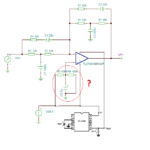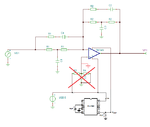David Kosman
Member level 1
- Joined
- Aug 30, 2015
- Messages
- 38
- Helped
- 1
- Reputation
- 2
- Reaction score
- 1
- Trophy points
- 8
- Location
- Czech republic
- Activity points
- 356
Follow along with the video below to see how to install our site as a web app on your home screen.
Note: This feature may not be available in some browsers.
Your bass filter uses an inverting opamp with its (+) input at 0V so its (-) input already has a bias voltage of 0VDC through the negative feedback resistor.
It is the lowpass filter opamp that is non-inverting that needs to have its input biased at 0VDC.



Your bass filter uses an inverting opamp with its (+) input at 0V so its (-) input already has a bias voltage of 0VDC through the negative feedback resistor.
It is the lowpass filter opamp that is non-inverting that needs to have its input biased at 0VDC.
Your ICL7660 is connected correctly but its 10kHz oscillator might be heard in the audio.
IN+ of your OPAMP should be GND. At least with the circuit and +5V / -5V supply of post#32.
NOPE, it was WRONG.Ok, so that post 27 was correct.

is that half way between +5V and -5V IS 0V.It shows an opamp with a +5V and -5V supply so its (+) input should be at half the supply voltage that is 0V.''